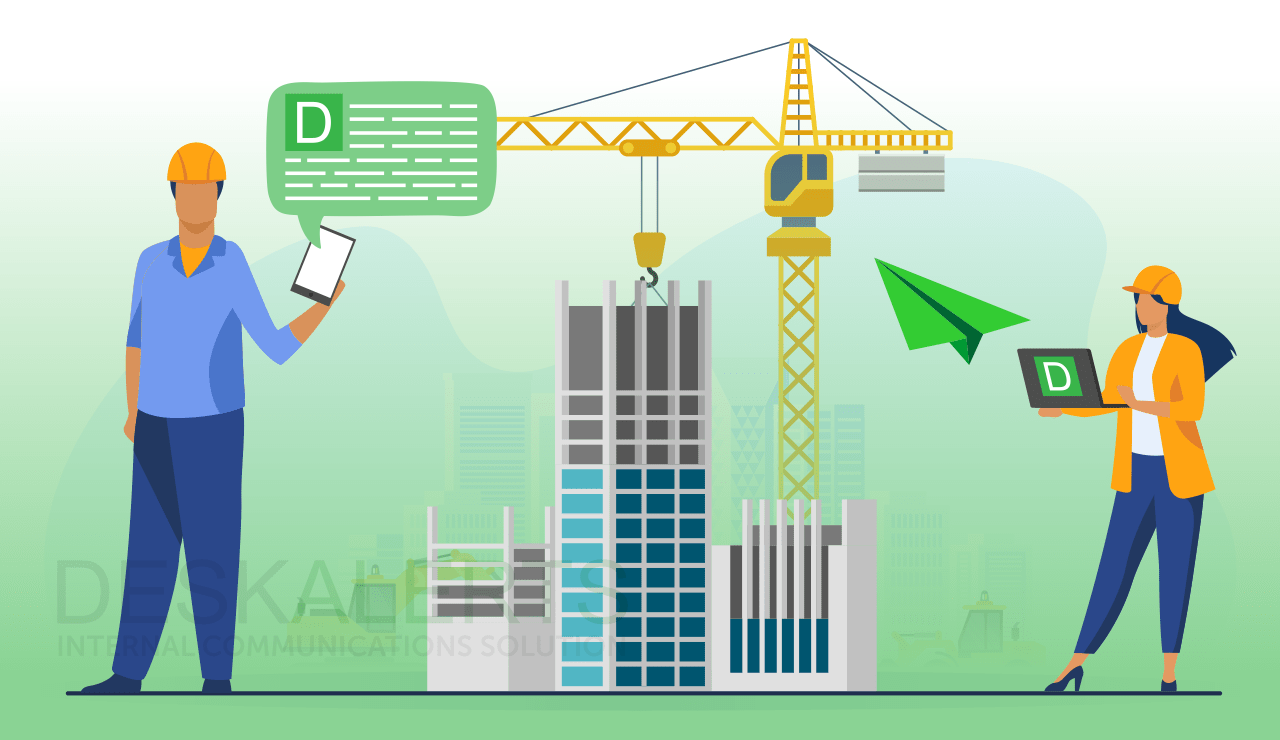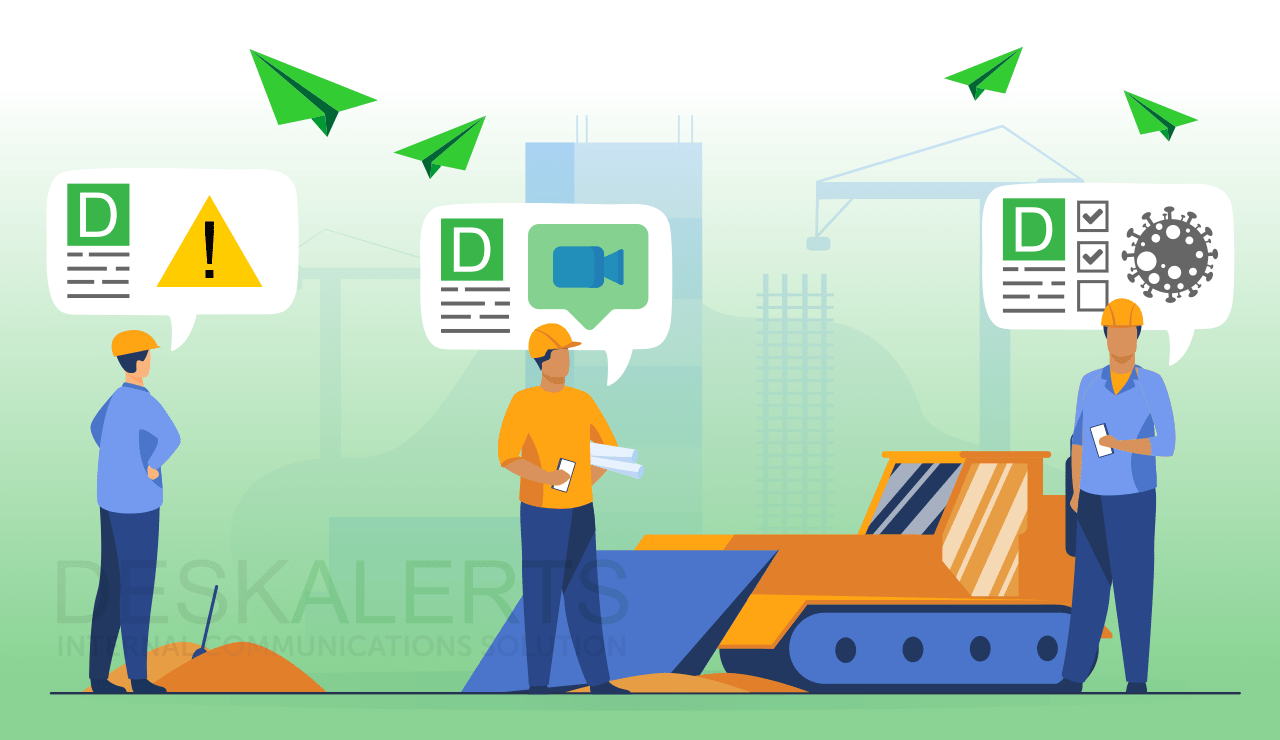 Like many industries, the construction industry has unique challenges when it comes to successful communication with employees.
Like many industries, the construction industry has unique challenges when it comes to successful communication with employees.
The nature of construction means that employees often work remotely, on the front-line, far away from the corporate headquarters. Construction companies may have multiple sites where their employees are located and on-site employees may feel isolated and disconnected from the company as a result of their ongoing remote working.
Across different industries around the world, there are 2.7 billion workers - including those in the construction industry - who don’t work at a desk. And they don’t always feel consulted and included.
Construction workers aren’t like office employees - they don’t have computers in front of them all day long where they can access the corporate intranet or receive emails. Workers on-site may have little-to-no contact at all with anyone from head office, and rely on their immediate supervisors for information.
According to authors David Maxfield and Joseph Genny in a 2017 Harvard Business Review study of 1153 employees, 64% of remote employees felt that their office-based colleagues made changes to the project without communicating.
Table of contents
Why communication is important in the construction
Common communication challenges in construction
Ways to improve communication in construction
Why communication is important in the construction
When internal communication is ineffective in the construction industry, a number of problems can arise that can result in major problems and delays on projects. This includes:
- Job dissatisfaction when employees are disengaged
- Low morale
- Higher levels of absenteeism
- Higher staff turnover
- More workplace injuries
- A lack of clarity around issues on site
- Employees not understanding project and/or company goals
- Employees not meeting expectations because they don’t know what they are
- Decreased productivity and profitability
- Increased risks
- Potential for legal issues to arise
In addition to this, miscommunication in construction can be costly.
According to a study by FMI Corp in 2018, the construction industry is out of pocket to the tune of $177 billion every year because of miscommunication with the high costs attributed to the time that it takes to find important project information and conflict resolution.
Working with these constraints and issues may be challenging, but proactively addressing them can have significant benefits for your company.

Common communication challenges in construction
Better communication will result in better construction project management - whether it’s a large project or a small one, it is critical that everyone is on the same page. These are some of the most common issues that the construction industry faces when it comes to communication:
1. A difficult to reach workforce
Construction sites can have hundreds of employees working on them at any time, across a range of skill sets. Some of them may work for the company, some may be contractors and some may be subcontractors. Not only can “information silos” develop, but the nature of this type of work can mean that silos develop within silos.
When communication with employees falls to managers on-site, there can be mixed outcomes. Someone may be an excellent engineer or builder, but it doesn’t mean they are naturally good communicators. Some people will be better at sharing information and keeping everyone informed than others, so the result on-site is inconsistent, particularly when there are different teams: one team’s manager may be a great communicator while another one’s isn’t.
Keeping everyone on the work site informed about issues and priorities can be the most challenging aspect of communication in the construction industry - especially when everyone there is remote from head office. Additional problems can arise when someone at corporate headquarters is making requests of staff on the ground that don’t accurately reflect what is happening at the job site because they are so removed from it.
This can result in mistakes if they are working off of outdated information or don’t completely understand local issues or can waste lots of time as employees on-site need to clarify information given and temper expectations.
2. Potential for health and safety issues
Construction sites are dangerous places. According to the International Labour Organization, when it comes to workplace accidents every year, the construction industry has a disproportionately higher rate. In the United States alone, one out of every five deaths in the workplace happens in the construction industry, according to the Department of Labor. Non-fatal injuries can cost companies millions of dollars every year.
There are many factors involved in ensuring safety on the work site, but communication is one of the most critical elements.
A study in 2019 by Dynamic Signal found 36% of employees had been placed in an unsafe situation as a result of poor communication in the construction industry.
Good construction communication can help you to establish a workplace culture of health and safety awareness, ensure that potential hazards are identified and shared with employees quickly, and clear instructions are given so that safety procedures can be followed.
3. Information shared is too complex
Good communication should be clear, concise, and easy to understand. In the construction industry, information that needs to be shared with employees by its very nature may be highly technical and complex. Other times the language used may be full of jargon or misused terms.
And, it isn’t just about the writing - plans and diagrams need to be made in an accurate and clear way too.
Finding ways to distill the information to make it more clear and succinct is important. When information is too complicated and too dense, people tend not to read everything and important advice can be lost.
4. COVID-19 causing additional issues
In many jurisdictions around the world, the construction industry has been declared an essential service and has been allowed to continue to operate. Sometimes this might be “business as usual” but in other cases, it has meant that construction sites have to operate with a reduced number of workers in attendance, which can slow up project timelines considerably. Other times, a positive COVID-19 case on-site can cause the worksite to be shut down for a period of time, leading to delays and uncertainty.
Because the situation can change very quickly, with little warning (government regulations changed, a positive case on-site) clear and concise communication with employees is essential.
5. Using inefficient internal communication channels
As mentioned earlier, methods of communication in the construction industry that are favored by non-construction industries don’t always work well in construction. Intranet and email may be accessed only very occasionally by on-site employees - or maybe even not at all.
This means that when there is something important everyone needs to know about, on-site employees may not get the information until it is too late, or may not get it at all. And when you’re relying on site managers to communicate with their people, as mentioned above, the results will vary depending on how good individual managers are at communicating.
6. Contractors not included in the mix
Building projects can use a mix of company employees and contractors. Contractors themselves may subcontract some of the work. Some contractors may be on site for the duration of the project, while others may only be involved for a short period of time, while they are needed.
Despite not everyone officially being employees of the same company, they still form a work team, working together on a project. Traditional communications may overlook these other workers on-site who have an equally important role to play to ensure the project is a success.
This can lead to misinformation, missing information, or delays in information being conveyed. Effective communication in construction takes into account everyone who is working on site.
7. Ineffective site meetings
Communication in construction projects often involves face-to-face meetings. On many sites, there are daily stand-up meetings where information is shared and priorities for the day are outlined. Other sites may have them less regularly.
Common issues that can arise through meetings are: bored and disinterested staff who aren’t listening, people who don’t understand something but are afraid to ask questions, there’s no opportunity given to ask questions, there are personal conflicts that make it hard for people to speak up about issues.
8. Language and cultural barriers
The construction industry is an increasingly multicultural one. It’s not uncommon to find people from a variety of different cultural backgrounds working together on the same site.
According to the US Bureau of Labor Statistics, foreign-born workers are 14% more likely to be employed in construction compared to native-born workers.
Language and cultural nuances can be a real problem in any workplace where this occurs. Even if employees speak a common language, there is scope for miscommunication as facts become lost in translation. It’s also possible to inadvertently cause offense.

Ways to improve communication in construction
Bad communication can spell disaster for your company when the stakes are high on expensive projects. Regardless of how big or small your projects are, ensuring that your internal communication processes are prioritized can lead to more favorable outcomes.
Steps to take include:
- Establishing formal communications chains: for effective communication management in construction, this will ensure that the right information gets to the right people, in the right place, at the right time.
- Ensure regular training is available and communicated about: when there are new procedures and processes to follow it’s important that people are trained properly - and also know about the training. Training material needs to be easy to understand and access. You may also find that employees are not following procedures properly and you may need to offer refresher training or issue reminders.
Learn more about the means of communication to effectively establish a new policy.
- Make sure there is two-way communication: top-down communication should not be the only way information flows on your construction project. Employees on the ground need to have ways to quickly communicate any issues to management so mitigation strategies can be put in place.
- Ask for feedback: finding out about issues isn’t the only time you should use two-way communication. It’s also important to get feedback from staff on the ground about anything that you have been doing.
- Use mobile-friendly communication channels: using an app to reach all workers on a construction site - both in-house employees and contractors - can solve a number of communications problems. You can be sure that the information will be sent quickly and everyone will be able to access it.
- Make sure information is sent in a timely manner: old and outdated information - or a delay in when employees receive new information - can lead to costly errors or increase health and safety risks.
- Ensure all communication is clear, factual, and professional: send well-written messages that are easy to understand, stick to the facts only and are relevant.
- Create custom audiences: you don’t want to overwhelm people with too much information that is irrelevant to them. There may be some comms that only people in corporate headquarters need to know about (for example, advising of a fire drill) and other comms that are specific to one work-site when you have multiple sites. Even on-site there may be custom audiences who need information: a team may need to know about a delayed delivery or revised time frames for the part of the project they are working on that doesn’t affect other teams. The targeted internal communication message is much more powerful!
- Be open and transparent: nobody enjoys delivering bad news, but failing to do so can result in rumors spreading and/or negative sentiment with employees. Over time such sentiment can fester and create a toxic workplace environment with poor morale and employees looking to work elsewhere.
- Automate communications when you can: if you know that certain things need to happen at a certain time, use communication channels that will allow you to create these in advance so that communication is ongoing and happens when it needs to. For example, DeskAlerts.
***
Your construction projects are the result of significant financial and time investments, often on behalf of clients. It isn’t worth risking them, or the health and safety of your employees, because of ineffective communication. Committing to improving the way you communicate with on-site workers will help to deliver better outcomes for everyone.
FAQs
How can I improve my communication skills in construction?
Construction communication skills can be improved by following these steps:
- Ensuring the establishment of a chain of command in communication
- Carefully select the right communication method for your messages
- Practice active listening
- Ensure all written communications are professional
- Ensure all communication is factual.
What is communication in construction management?
Communication in construction management refers to the way that opinions, ideas and knowledge is shared between colleagues who are working on the same project so that they can achieve common goals.
What forms of communication may be used on a construction site?
There are several types of communication that can be used on a construction site. This includes:
- Face-to-face
- Cell phones
- Flags, lights and alarms for emergencies
- Mobile employee communication apps.
What are 3 advantages of good communication on a construction site?
Three of the main advantages of good communication on construction sites include:
- A more cohesive work team
- Improved trust between management and employees
- Greater productivity.
 Caroline Duncan
Caroline Duncan
 Like many industries, the construction industry has unique challenges when it comes to successful communication with employees.
Like many industries, the construction industry has unique challenges when it comes to successful communication with employees.






